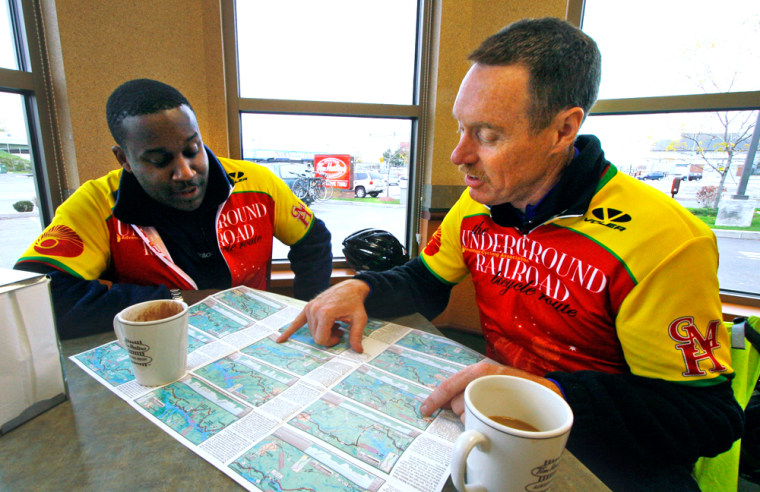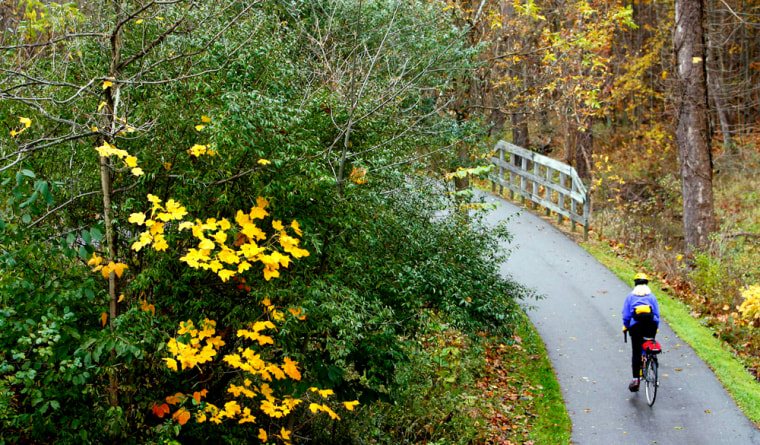While there's no one path that escaping slaves took to claim their freedom, cyclists can get a sense of some of America's Underground Railroad history from a new bicycle route of 2,100 miles that cuts from coastal Alabama up to Canada.
The last three sections of the Underground Railroad Bicycle Route run from Owensboro, Ky., through Indiana, Ohio, Pennsylvania and New York, ending in Owen Sound, Ontario.
Earlier sections trace the route from Mobile, Ala., across to Mississippi, through Tennessee, into the Land Between the Lakes in western Kentucky and north to Owensboro.
"As people experience this route, they are going through small towns and neighborhoods, meeting people whose stories will intrigue them and they'll be able to share their experiences," said Ginny Sullivan, new routes coordinator for the Adventure Cycling Association, which mapped the route.
"It brings cyclists to the real America," she said.
While there is no singular route that slaves took to freedom, the cycling group wanted to choose a route representative of the freedom trail that would also wind through areas of historic significance.

Mobile was chosen as a starting point because it once served as an entry point for slave ships. The Canadian end point of Owen Sound bills itself as "the Underground Railroad's most northerly safe haven" and is holding its 145th annual Emancipation Celebration Festival Aug. 3-5.
The cycling association developed the route in partnership with the Center for Minority Health at the University of Pittsburgh. The project's goals include diversifying the demographics of the bicycling set, while encouraging black Americans to seek out their cultural history and improve their health through biking.
"We see it as a part of our mission overall to eliminate health disparities between races," said Mario Browne, a project coordinator with the Center for Minority Health. "Minority communities experience a higher incidence of mortality from diabetes, cardiovascular disease and hypertension."
Bicycling just 30 minutes a day can help ease those problems with minimal cost.
"Small steps can lead to big rewards," he said. "Cycling is something that people can do basically year round at a gym or in their basement ... You don't have to be Lance Armstrong to do it and see the benefits."
Barry Zalph, executive director of an advocacy and educational group in Kentucky called Bicycling for Louisville, lobbied for the route to go through the Louisville area. Zalph's group encourages low-income and minority youths to take their bikes outside their neighborhoods.
"The beauty of the Underground Railroad route, passing as close as it does, gives us the opportunity to create local loops and routes for local riders to stick their toe in the water," said Zalph, who added that he'd like to "expand cycling beyond the college-educated white guys over 40 group."
Additional spurs are planned to connect other regions to the original route. One spur is planned from Erie, Pa., to Pittsburgh, with the hope of eventually connecting to Washington, D.C.
The group has also contacted libraries along the route to let them know that riders may come through their doors seeking a dry spot or relief from the heat.
"Cyclists like to use libraries to check the Internet to keep in touch with their home and e-mail," Sullivan said.
The maps provide detailed directions, lodging information and other services cyclists might need along the way. Field notes in the maps also give the traveler historical context for some of the spots along the way.
Those planning their own bike trips on the route could cover the entire length of the route traveling 75 miles a day for about a month or so.
This spring, ACA will sponsor a trip from April 14 through May 31, leading a group of riders from Mobile to Ontario. A shorter trip midsummer will go from Buffalo, N.Y., to Ontario.
Dallas and Joyce McKenzie researched the route for ACA by traveling the proposed itinerary in a recreational vehicle and by bicycle. They trekked about 125-150 miles a day, taking extensive notes on necessities for riders like places to get a hot shower, bike shops, low traffic roads and highways with shoulders.
McKenzie, a retired American history teacher who lives in Lenexa, Kan., says the route is meant to give riders a sense of the route a slave might have taken. "We tried to follow the river as best we could," McKenzie said, "and let the riders encounter most of the landmarks."
He notes that Kentucky will give riders the type of adventure ACA members are seeking. "The scenery is fantastic, history is plentiful, and the challenge certain to bring out the best in any serious cycling tourist," McKenzie said.
